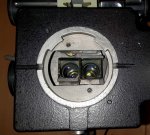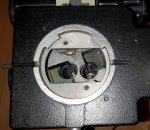Dear Choledric,
Your system is smart and elegant, but, I think that it will not be efficient, inthe sens you are loosing lot of Raman signal, may be you are just collecting 25% of the total signal that you can.
In fact, the objective collects the Raman signal, but haf goes to the right and the other half goes to the left, here you have 50% losse
then, half of the signal goes to the eyepiece-SMA and half goes to the camera.
I frankly think that you can increase the Raman signal by a factor of 4!
but, still bright idea for strong Raman emitting materials.
please, can you advise and share how you converted your eyepice to to an SMA-connector?
thanks a lot
C
Hello Civitus,
I would like to discuss with you here, because that's the most effective way to experience and exchange ideas.
That's just the basis of communication.
For this reason, I sometimes put here one or the other facet something irritating.
In this sense I would like to contradict you in a few points:
- As already described above, I swap out the two beamsplitter at the recording of the spectacle from the beam path.
For this purpose a lever on the left side of this assembly moves the two beam splitters. To illustrate it I took up the tube head.
In picture 1 you can see the two beamsplitter swung in, the picture 2 then partially swung out , and in picture 3 these are completely swung to the side and no longer in the beam path.
The intermediate objective revolver (referred to in the sketch as the galilei system) can be brought to a throughput position and in this position no additional lenses or other optics are in the beam path.
The first 50% loss described by you are then already no longer available, because the laser goes directly to the sample without any obstacle and the ramansignale directly back through the lens through the langpassfilter in the colimator.
This then collects the light at the focal point on the input of the fiber optic.
In others systems you have to find a way to coupli in the laser beam in the optical path, here it is no so and i spare some losts, because no such part (like a dicro, mirror or cube) is in the path.
- Since the raman signals have a random emission direction, the small convergence angle of 13 ° is not particularly relevant, as long as the structures on the sample surface do not shadow, in the 90 ° solution that may be a problem.
In a 0 ° system, the signal goes so synonymous through the lens, but my lens is much larger in diameter (48mm!) and thus considerably brighter.
Certainly, the just described convergence angle and the large working distance is a disadvantage,
but with this system I have to compromise, because I want to be able to cool the objects under investigation in a chamber with a quartz window and the minerals to be examined can have a certain size and do not fit under a normal microscope.
I know this system is not optimal, but it's just one of several solutions I share and is is built with parts i have.
Over the next few weeks I will introduce the two other assemblies that have other advantages and disadvantages.
First there will come the from you desired detail-description of the sma connection, this is a bit of work, so please be patient with me.
Then I am looking forward to fruitful discussions and exchange of opinions.










